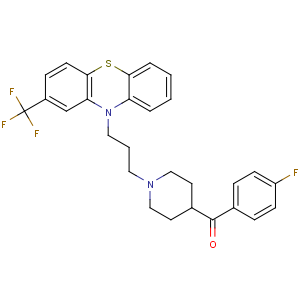Title: Fibroblast Growth Factor
CAS Registry Number: 62031-54-3
Synonyms: FGF
Literature References: Growth stimulatory factor originally isolated from bovine brain and pituitary and found to stimulate DNA synthesis in cultured fibroblast cells. Isoln: D. Gospodarowicz,
Nature 249, 123 (1974). Mitogenic effect on cultured cell lines and induction of amphibian limb regeneration
in vivo: D. Gospodarowicz
et al., Adv. Metab. Disord. 8, 301 (1975). Two closely related forms have been identified, known as basic (
bFGF) and acidic (
aFGF) fibroblast growth factors, having a total amino acid sequence homology of 55%. Both induce the proliferation and differentiation of a wide variety of cell types, including corneal and vascular endothelial cells, myoblasts, chondrocytes, osteoblasts and glial cells. FGF has neurotrophic and angiogenic activity and may play an important role in the wound healing process. Purification of bFGF from pituitary: D. Gospodarowicz,
J. Biol. Chem. 250, 2515 (1975); from brain: D. Gospodarowicz
et al., ibid. 253, 3736 (1978). Identification of aFGF from bovine brain: K. A. Thomas
et al., ibid. 255, 5517 (1980). Comparison of fibroblast growth factors: S. K. Lemmon
et al., J. Cell Biol. 95, 162 (1982). Purification and characterization of aFGF: K. A. Thomas
et al., Proc. Natl. Acad. Sci. USA 81, 357 (1984). Identity of bFGF from brain and pituitary: D. Gospodarowicz
et al., ibid. 6963. Amino acid sequence of bFGF: F. Esch
et al., ibid. 82, 6507 (1985); of aFGF: G. Gimenez-Gallego
et al., Science 230, 1385 (1985); F. Esch
et al., Biochem. Biophys. Res. Commun. 133, 554 (1985). Possible identity of aFGF with
endothelial cell growth factor (
ECGF) and
eye-derived growth factor-II (
EDGF-II): A. B. Schreiber
et al., J. Cell Biol. 101, 1623 (1985); of bFGF with
macrophage-derived growth factor (
MDGF): A. Baird
et al., Biochem. Biophys. Res. Commun. 126, 358 (1985); of FGFs with
retina-derived endothelial cell growth factors: A. Baird
et al., Biochemistry 24, 7855 (1985). Cloning of cDNA for bovine bFGF: J. A. Abraham
et al., Science 233, 545 (1986); for human bFGF: T. Kurokawa
et al., FEBS Lett. 213, 189 (1987); M. Iwane
et al., Biochem. Biophys. Res. Commun. 146, 470 (1987). Expression of a chemically synthesized gene for bioactive bovine aFGF: D. L. Linemeyer
et al., Biotechnology 5, 960 (1987). Receptor binding study: G. Neufeld, D. Gospodarowicz:
J. Biol. Chem. 261, 5631 (1986). FGF-like factors have been isolated from several human tumor cell lines: R. R. Lobb
et al., Biochem. Biophys. Res. Commun. 139, 861 (1986); M. Klagsbrun
et al., Proc. Natl. Acad. Sci. USA 83, 2448 (1986); D. Moscatelli
et al., J. Cell. Physiol. 129, 273 (1986). FGF has also been shown to be structurally homologous to the protein products of several oncogenes: C. Dickson, G. Peters,
Nature 326, 833 (1987); M. Taira
et al., Proc. Natl. Acad. Sci. USA 84, 2980 (1987); P. Delli Bovi
et al., Cell 50, 729 (1987). Review of tissue distribution and bioactivity of bFGF: A. Baird
et al., Recent Prog. Horm. Res. 42, 143-205 (1986). Review of structural characterization and biological functions: D. Gospodarowicz
et al., Endocr. Rev. 8, 95-114 (1987). Potential role in the control of pituitary and gonad development: D. Gospodarowicz, N. Ferrara,
J. Steroid Biochem. 32, 183-191 (1989).
Reviews: K. A. Thomas, G. Gimenez-Gallego,
Trends Biochem. Sci. 11, 81-84 (1986); D. Gospodarowicz
et al., Mol. Cell. Endocrinol. 46, 187-204 (1986); K. A. Thomas,
FASEB J. 1, 434-440 (1987).
Derivative Type: Acidic fibroblast growth factor
CAS Registry Number: 106096-92-8
Properties: pI 5-7. Exists in 2 microheterogeneous forms:
aFGF-1, a 140 amino acid peptide, mol wt 15,900 daltons, and
aFGF-2, an amino truncated form lacking 6 amino terminal residues, mol wt 15,200 daltons.
Derivative Type: Basic fibroblast growth factor
CAS Registry Number: 106096-93-9
Properties: pI 9.6. 146 amino acid peptide, mol wt ~16,000 daltons. Also exists as an amino truncated form,
des 1-15 bFGF, lacking the first 15 amino acid residues.

